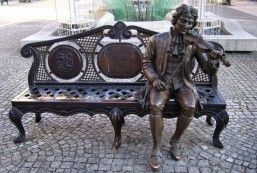
Double Talent in Classical Tradition |
Ernest Hiltenbrand’s parents passed on their love for the arts and music. He decided to follow not just one, but both roads: Painter and musician.
Niklaus Rüegg – Ernest Hiltenbrand started, thanks to an arts-inspired household, to draw and paint with watercolors at an early age. Following his middle school graduation, he wanted to attend the arts and
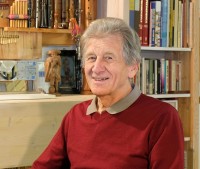
crafts school, but was considered too young with sixteen years. Instead, he chose the path of an artistic glass maker. During his training, he also started horn studies at the Conservatoire de musique de Strasbourg. Back in time, French law stipulated that any music studies must be accompanied by a secondary profession. After three years of study, he had the opportunity to contribute to the restoration of the windows of the Strassburger Münster. Following his music studies, he received his orchestral placement at the symphonic orchestra of Quito, in South American Ecuador. He received a three-year contract, but had to return to France after just one year, to complete his military service. He moved to Paris and played in the French military orchestra. After two years of service, he joined the orchestra of the Strassburg opera for a year, before getting a position with the 'Musikkollegium Winterthur' in 1968. Ernest Hiltenbrand then stayed with this orchestra for 40 years.
The time in Quito in the sixties had a profound impact on his life. Until today, he spends up to two months of every year in Ecuador, playing music and working on developmental projects with the indigenous population.
Principles in the Arts
As of today, the 74-years old artist is active in Zürich’s Wiesendangen, as a freelance painter and compo

ser. As a painter, he mostly works on large format oil paintings. He covers a broad stylistic field. Abstract works stand in contrast to «sacral» paintings, sometimes in the form of archaic interiors, as known from medieval churches. The painter and composer takes inspiration from proportions, harmony and clear structures of the Baroque and Classic: «In the Baroque and Renaissance era, art was created by following strict principles. Similar principles apply in music. Until the Romantic era, chords had specific functions». Johann Sebastian Bach counts among Hiltenbrand’s biggest inspirations. He composes tonal music, inspired by harmonic principlces of Classical music. While painting, he likes to include the theory of shapes and colors, and the golden ratio. He values Baroque and Impressionst painters. The effect of light and colors are a characteristic of his oil paintings. His abstract series often remind of church windows. «I love to transpose the illustriousness of Gothic cathedrals, the mood of sacral room», states the artist.
He started composing for practical reasons: Whenever he wouldn’t find appropriate literature for his recorder, pan flute and horn students, he would compose pieces of appropriate difficulty. It didn’t take long until music ensembles and individuals took note and started commissioning pieces. In the meantime, he has reached opus 159. He is current working on an arrangement of the song 'Die Himmel rühmen' by Beethoven, for a recorder ensemble. The edition does not strictly follow the original work, but contains a few original elements.
The Guggisberg-Song as an Instrumental Version
Hiltenbrand’s music is sold by three publishers. A special work is the Elegy written in 2013, inspired by the Swiss traditional Guggisberg-Song, for viola and piano, Op. 118 B, which recently appeared with pu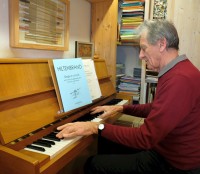 blisher Viola Viga. 'B' indicated an arrangement. The original is written for horn. Horn and viola are easily exchangeable, says Hiltenbrand: «I sat behind the orchestra’s viola section for 40 years. That’s why I know this instruments very well. The sound is similar to the French Horn». But why did he arrange the Guggisberg-Song? Hiltenbrand: «It is one of the few Swiss traditional songs written in a minor key. I like to compose in minor keys, for I prefer the melancholic aspects over the joyous ones».
blisher Viola Viga. 'B' indicated an arrangement. The original is written for horn. Horn and viola are easily exchangeable, says Hiltenbrand: «I sat behind the orchestra’s viola section for 40 years. That’s why I know this instruments very well. The sound is similar to the French Horn». But why did he arrange the Guggisberg-Song? Hiltenbrand: «It is one of the few Swiss traditional songs written in a minor key. I like to compose in minor keys, for I prefer the melancholic aspects over the joyous ones».
Appropriate online representation of his art is always a concern of his. He composes with music software and uses the 'Vienna Symphonic Library' for enhanced realistic playback. He also likes to add slideshows of his paintings to the compositions.
Pictures: © 2020 Mark Walder
Sheet msuic by Ernest Hiltenbrand |
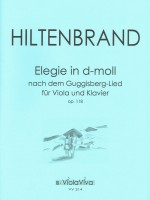
Ernest Hiltenbrand
(1945*)
Elegie in d-minor
for Viola & Piano
» to the product

(1945*)
Oraison Irlandaise
Duo for 2 Violas
» to the product
Paintings by Ernest Hiltenbrand |
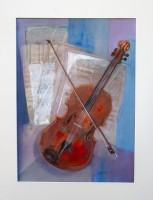
Oel on watercolor paper
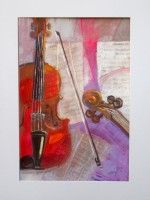
Oel on watercolor paper
| This might also be of interest to you |
» To the viola blog
 Do you don't want to miss any news regarding viola anymore? Our monthly viola news letter will keep you informed.
Do you don't want to miss any news regarding viola anymore? Our monthly viola news letter will keep you informed.» Subscribe to our viola letter for free

Visit and like us on Facebook.
» Music4Viola on Facebook
